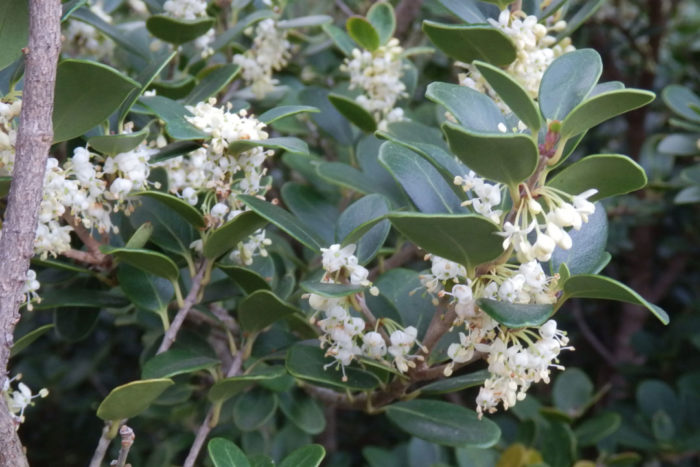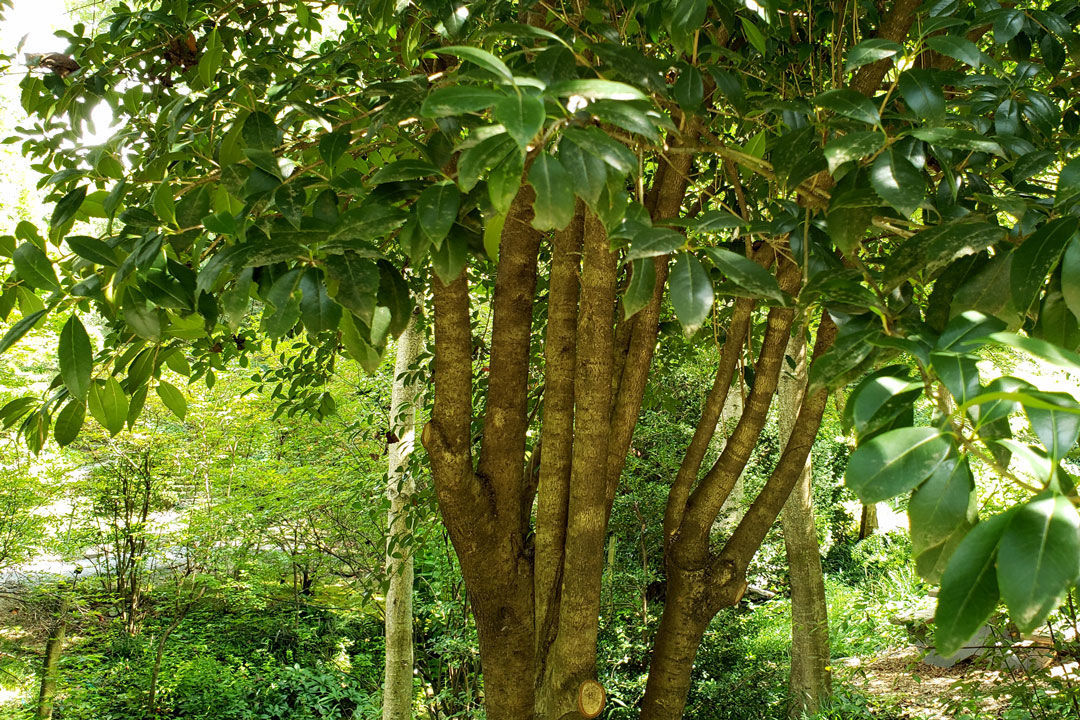
If magnolia (Magnolia grandiflora, Zones 7–9) and gardenia (Gardenia jasminoides, Zones 8–11) are the iconic plant perfumes of Southern summers, tea olive (Osmanthus spp. and cvs., Zones 6–11) breezes in to take over that role in fall. Hang out near a tea olive in bloom and I guarantee you’ll overhear a few passersby wondering, “What’s that amazing smell?” Ironically, all three of these are Asian plants, but to us they’re as Southern as sweet tea. Just as there is an occasional Southerner who eschews that beverage, there is a small subset of folks who can’t take the weight of tea olive’s sweet, apricotlike fragrance. I learned this the hard way when I once presented a potential beau with a bouquet of cuttings and got the reply, “It smells like a funeral parlor.” I wilted, but my affection for the plant only took a brief hit.
Since then it has grown considerably as I’ve gotten to know many species and cultivars of tea olive. They have much more to offer than just a stop-you-in-your-tracks seasonal fragrance. All are evergreen shrubs (many can be trained into tree-form), are practically pest free, and tend to be passed over by deer. In full sun to partial shade with decent drainage and even moisture, they will grow at a nice clip. Tea olives thrive in our hot and humid Southeastern conditions, and they tolerate drought and most clay soils. Cold hardiness varies from Zone 6 to Zone 8.

Fragrant tea olive (O. fragrans, Zones 8–11), also called sweet olive, is—no surprise—the most fragrant of all tea olives and blooms for the most extended period of time. Ted Stephens of Nurseries Caroliniana in North Augusta, South Carolina, cleverly observes that they bloom “in every month with an R in it,” although this is true most heavily in October and November. This is the least cold hardy species—most selections are hardy to Zone 8, with a few forms hardy into Zone 7. The powerfully fragrant blooms range from white to cream, yellow, or orange but are often hidden by the finely toothed to smooth-edged leaves. Two selections put on a visual, as well as olfactory show: ‘Fodingzhu’ and orange-flowering tea olive (O. fragrans f. aurantiacus, Zones 7–11). The cultivar ‘Fodingzhu’ is a flowering beast. The rounded clusters of creamy flowers cover the stems in fall, almost obscuring the foliage. Orange-flowering tea olive may blend into the background all summer but will demand your attention when it comes alive with bright, clear orange flower clusters in fall. It is more cold hardy than the species, extending into Zone 7. Fragrant tea olive typically grows to about 15 feet in the Piedmont and up to 25 feet at the coast, but it responds well to pruning.

False holly (O. heterophyllus, Zones 6–9), also called holly tea olive, is one of the most cold-hardy species. Its clusters of small flowers occur only in fall and are fragrant at close range. Younger specimens bear prominently spiky leaves, hence the holly reference. As the shrub matures, more and more leaves change form, becoming smooth-margined. At mature height (8 to 15 feet), most leaves are smooth. Cultivars abound within this species, especially ones with striking leaf variations such as ‘Goshiki’, ‘Rotudifolius’, ‘Sasaba’, and ‘Variegatus’. ‘Goshiki’ is becoming a go-to standard for gardeners looking for a burst of color in a tough little package. Its new growth swirls with shades of pink, cream, yellow, and orange. By summer, colors have shifted to shades of cream and green but are still very striking. It has dense, compact growth, reaching 4 to 5 feet tall and wide at maturity. All it lacks are the typical fragrant flowers, but no one seems to be complaining!

Fortune’s tea olive (Osmanthus × fortunei, Zones 7–11) is a hybrid between the two previously mentioned species. It has the intense aroma of fragrant tea olive and gains increased cold hardiness from false holly, making it a popular choice through Zone 7. In youth, its shiny leaves are attractively toothed, yet not as spiny as false holly, and many will shift to smooth-margined at maturity. While mature shrubs can reach up to 20 feet tall, they respond well to significant pruning and can be kept down to one-third of that height. The two most common cultivars are ‘San Jose’ and ‘Fruitlandii’, both bearing white bloom clusters in October.
Other species of tea olive, such as delavey tea olive (O. delavayi, Zones 7–10) and burkwood tea olive (Osmanthus × burkwoodii, Zones 6–9), with their early spring blooms and sweet but light fragrance, are worth exploring as well. And for our friends in the colder parts of Zone 6, toothed sweet olive (O. armatus, Zones 6–9), with its striking elongated leaves, is considered the most cold hardy of the fragrant fall bloomers.
—Paula Gross is the former assistant director of the University of North Carolina at Charlotte Botanical Gardens.
Fine Gardening Recommended Products

ARS Telescoping Long Reach Pruner
Fine Gardening receives a commission for items purchased through links on this site, including Amazon Associates and other affiliate advertising programs.

Corona Tools 10-Inch RazorTOOTH Folding Saw
Fine Gardening receives a commission for items purchased through links on this site, including Amazon Associates and other affiliate advertising programs.

A.M. Leonard Deluxe Soil Knife & Leather Sheath Combo
Fine Gardening receives a commission for items purchased through links on this site, including Amazon Associates and other affiliate advertising programs.



















Comments
Log in or create an account to post a comment.
Sign up Log in